Okay, when I bought this Tascam MD-CD1MKIII deck I knew it looked mint, but until I started digging in the menus I never realized it had so few hours on it as well!


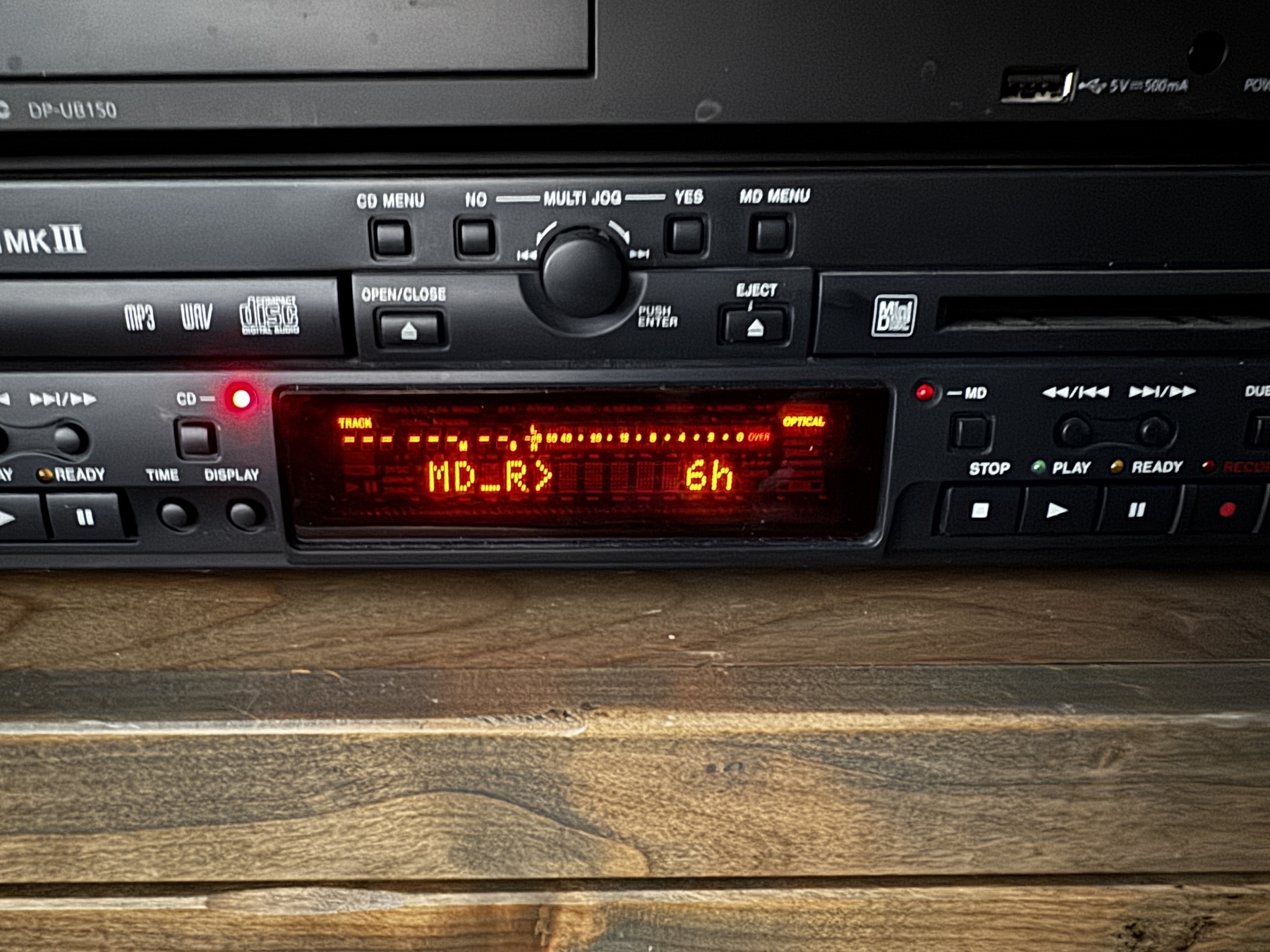
Damn, this thing was hardly touched!
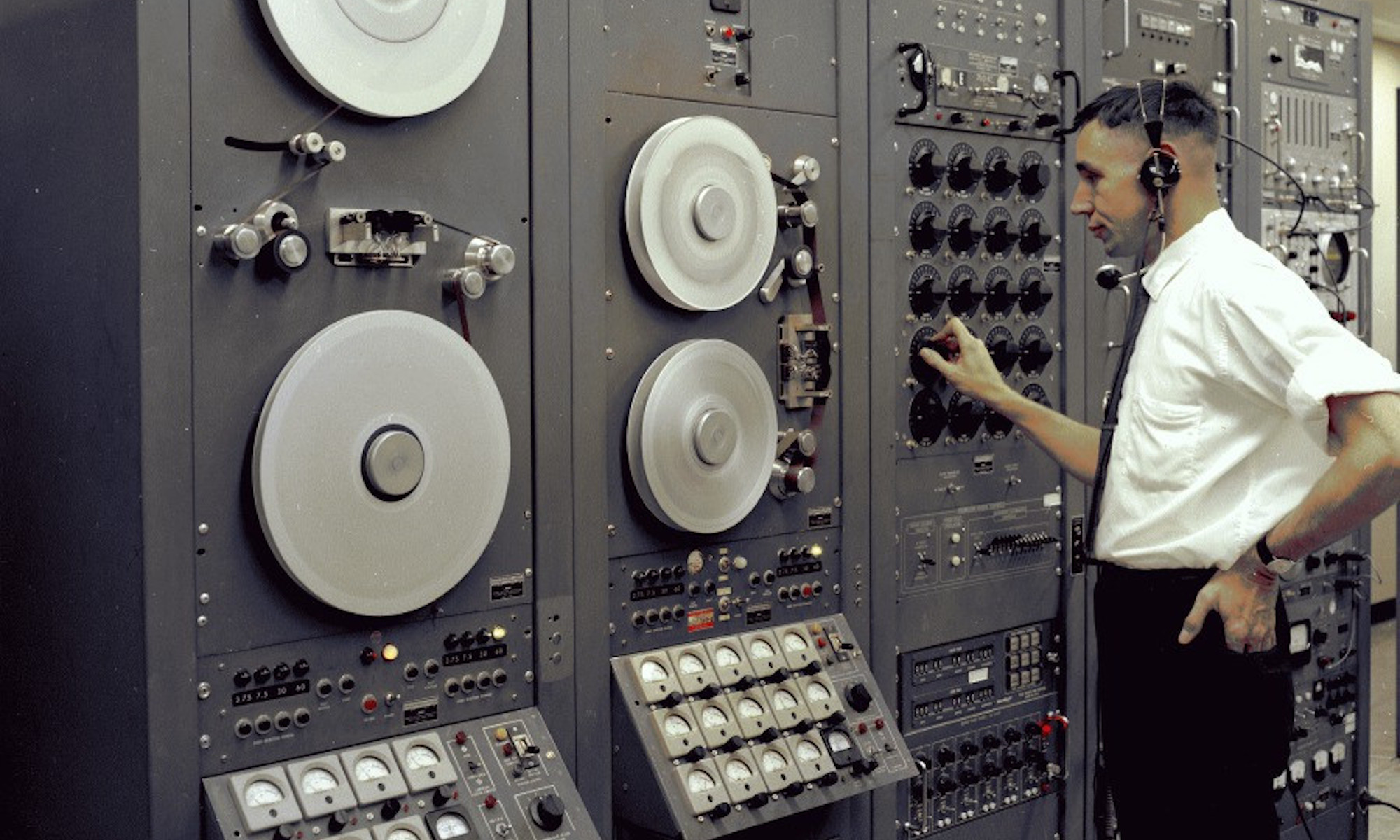
Once a legitimate blog. Now just a collection of memes 'n menz.
Okay, when I bought this Tascam MD-CD1MKIII deck I knew it looked mint, but until I started digging in the menus I never realized it had so few hours on it as well!



Damn, this thing was hardly touched!
Very happy with my first foray into Japanese auctions! Upon arrival it powered up fine with an AA sidecar battery and/or power adapter, but wouldn't recognize a perfectly good, fully charged internal gumstick battery—nor would it charge said gumstick. Even though the contacts on the external battery door looked okay, I knew there had to be corrosion inside, so after shining a flashlight in the battery compartment and confirming the internal contacts were caked with the infamous green corrosion, I gingerly removed the rear case. Armed with vinegar, an old toothbrush, q-tips, and isopropyl alcohol—and having watched numerous videos on how to do it—I set about removing the green gunk. Afterwards I put it all back together—and to my utter amazement, not only did it still work, but now it recognized the gumstick battery and even worked! And that color! Sony sure knew how to do orange!
I'm surprised how quickly I got that task done.
One of the few things I had planned for post-retirement was de-fuckifying my office closet. Over the past two years it became a catch-all for anything I didn't want to deal with, and among the things I didn't want to deal with were the two Kenwood receivers I once waxed poetic over and the Yamaha amp and CD player that were rotated out of my audio setup.
They were already boxed up and ready to eBay, but I kept putting it off for a variety of reasons: they needed to be unboxed and photographed, the auctions needed to be created, yada, yada, yada. It was always some excuse.
So jumping the gun a bit, about six weeks ago I decided to get the process started, and one weekend I removed them from the closet, unboxed them, and photographed everything. The next day I posted it all on eBay.
One receiver sold within 72 hours. The second followed a few days later. I was kind of surprised, actually. I also offloaded a spare turntable dustcover almost immediately. The CD player went about two weeks ago, and today, the Yamaha amp finally sold. Everything was at a slight loss from what I'd hoped to get, but I didn't do this to make money; it was simply to get the stuff out of here and into the hands of someone else who would appreciate them as much as I have.
Next up on the auction block is the Yamaha T-1 tuner I got a little over a year ago. It's an absolutely stellar tuner; an item I lusted after when I was a teenager, haunting the showrooms of Jerry's Audio, but it's been sitting virtually unused all this time. I was happy to finally get one, but I haven't used it more than couple dozen times since purchasing it and for all intents it was just gathering dust. And my anal retentive self also didn't appreciate the fact that the black anodized finish didn't match the the Yamaha amp I'd paired it with (the tuner and amp series were about half a decade apart, so it's understandable stuff changed) so it was pretty easy to let it go. It also helps that I just picked up one of the tuners that came out at the same time as the amp for a song. I guess no one is really listening to radio any more, but I do want to have one on hand in the case of some emergency.
I recorded my first minidisc in over a decade last night.
And after I finished, ejected the disc so it could finish writing the table of contents, and when I reinserted the disc to listen, the machine took a crap. C13 Read Error. Ugh. And it wasn't just that disc—it was even brand new, unused ones. And of course the seller I bought it from said it was fully functional and doesn't accept returns.
Being a nerd that's still relatively good at fixing shit, I did a hasty search online and ended up getting very depressed. Firstly, because there wasn't a whole lot of info out there and a lot of it was, "Take it to a Sony Service Center." Yeah, like that's an option any more…
I did all the suggested troubleshooting: cleaning the laser's lens, blowing out the mechanism with compressed air, reseating the ribbon cables that run between the mechanism and the main circuit board, etc. But none of it worked.
Anyhow, after mulling it over while wide awake at 4 am this morning, I thought about one other possible culprit: dried lubricant on the sled rail.
After getting ready this morning, did a search on YouTube and found one video that described the error and what needed to be done. It was basically everything I'd already done, but I felt that if the guy in the video could resuscitate a machine that was in much worse condition than mine, I certainly could get this one working.
I pulled the top off again and did everything I'd done last night and in addition, ran a Q-tip drenched in isopropyl alcohol along the rail and under the gears that drive the mechanism. I cautiously inserted the disc from last night and viola! it worked!
So fingers are crossed. As I type this I'm adding a few more tracks to the disc from last night and so far everything is working as it should. The true test will be when I'm finished and it has to write to the TOC (Table of Contents) before ejecting…
UPDATE: It worked!
UPDATE #2: It's hosed. After recording two discs, the error returned. After popping the cover was obvious the disc was refusing to spin up, triggering the C13 error. I spoke to the seller this afternoon and she's agreed to refund what I paid for it upon return of the unit. On the positive side, the MZ-S1 arrived today and it works like a champ.
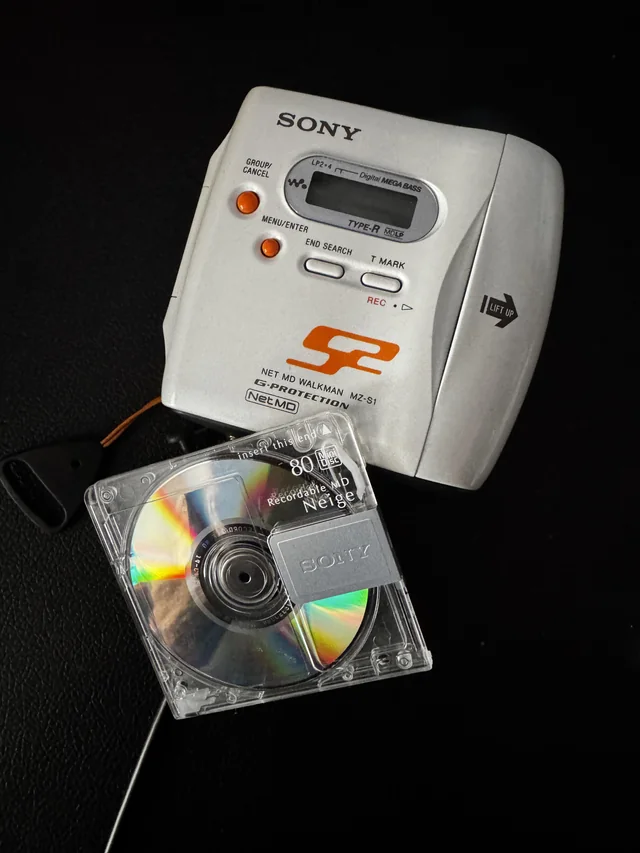
…but I've settled on my favorite combination for deskside CD playback.

I never really intended to jump back into the portable CD lifestyle after abandoning it with the advent of iPods and later iPhones, but yet here I am. I'm currently listening to the complete Koyaanisqatsi score at angelic volume and truth be told, I'm loving it.
This was the first second portable CD player I owned shortly after the format showed up, back in the mid 80s. (The first was a Sony D-7, and I had nothing but issues with the headphone jack on that unit so I'm in no hurry to get another one.) Of the four players I now own, this one, hands-down, produces the best sound. Even though it's been fully serviced, I was still surprised how much noise the laser sled assembly makes when searching for tracks or when returning to its rest position at the end of play. It's also extremely sensitive to shock and vibration, something I have no memory of from back in the day. I know I used to drag it between my apartment and office downtown, tucked away in my backpack while I walked to and from MUNI stations and while riding the train but I certainly don't remember it being as skip-prone as this particular example is. Or maybe it's just like I wrote before: we didn't expect perfection and just lived with it. It's a question I suppose I'll never have a definitive answer for. Nostalgia notwithstanding, I also think it's among the best looking players that Sony ever produced. An all-metal enclosure, and a (in the case of this particular unit, a rebuilt, modernized) battery pack that clips on the bottom spoke to Sony's attention to quality and design.
This was supposedly the direct descendant of the D-10. It's marked by some design changes and improvements internally as well as externally. It also sports the addition of LED illumination in the display window (when the player is plugged into mains at least) and an internal battery pack. The sound from the D-15 is very close to the D-10, so much so that I'm hard pressed to find any huge real differences. Like the D-10, the case is solid aluminum, giving it a nice heft. The mechanism in this—also fully serviced—unit is much quieter than the D-10. And even though neither units possess anything resembling Sony's later "G-Protection" shock technology, I've found this player to be still more resistant to bumps and other jostles than its predecessor, and when bumped seems to recover a tad more quickly. In addition to the built-in battery pack, like the D-10, it can use the same external clip-on-the-bottom-of-the-unit BP-100 battery pack, although the guy whom I bought the D-10 from warned me not to charge the rebuilt BP-100 through the D-15 because of some voltage differences required by the newer battery formulation he used in the rebuilt unit and had compensated for in the D-10. So better safe than sorry since he obviously knows more about electronics than I do. I can power it from the BP-100, but I can't charge the BP-100 through the D-15.
As mentioned, the D-15 does have a provision for an internal rechargeable battery pack, but of course Sony no longer makes them. Thankfully there are third-party replacements available that can be recharged through the player itself or via a standard USB-C charger. I have one on order…
The one thing both the D-10 and the D-15 suffer from is an extreme sensitivity to dirty or scratched discs. Whereas the two later players (below) will handle most everything without a hiccup, the tiniest speck or scratch will cause these two to lose their minds, sometimes never recovering. I'll put a disc in and halfway through will start stuttering. I will pull the disc out and look at it under bright light, and yeah, sure enough, there's a partial fingerprint or a tiny speck of schmutz that I didn't see before. So I'm trying to get in the habit of wiping down each disc beforehand that I play in these units.
This is my old workhorse, purchased new in 1998 and put in storage at some indeterminate date. I pulled it out when I really started getting back into CDs (after remembering I still had it) and have enjoyed using it again. Obviously a decade had passed between the D-25 and the D-171, and in those intervening years Sony really got the design of these machines down to a fine art. Gone are the multi-level circuit boards and dozens of snaking wires. All the circuitry is now on one board. The D-171 is all plastic, but has held up amazingly well over the years. Still no skip-protection circuitry, but it does handle jostling better than either of the two earlier models, recovering almost instantly if it receives a direct hit. It also has something called "Mega Bass" that offers two increases in bass frequencies, neither of which are particularly welcome to my ears. When doing a direct comparison, the overall sound quality is rather muddy and a little "thin" in comparison to either the D-15 or the D-10 through my Grado over-the-ear cans, but certainly okay when listening through a pair of Skull Candy earbuds (dating from 2016 or thereabouts) while falling asleep. It also has the advantage of being powered by standard Double-A batteries (including the Duracell/Energizer rechargeable variety) when not plugged into the mains. Supposedly there was a rechargeable battery pack available that charged through the D-171 itself and slipped into the standard Double-A slots, but I never owned one back in the day and while there are replacements available online, I honestly don't see the need. The laser sled is still quite audible when searching or returning to its rest, but it's neither louder or quieter than the D-15. And as I discovered last week, the D-171 also has the advantage of being extremely easy to get into for repairs.
Tuesday night as I was getting ready for bed, I popped a CD in and pressed play and saw the disc try to spin up and then stop, giving me the dreaded "No Disc" error on the display. Wondering if it was the disc itself, I tried another one with the same results. With it being too close to midnight for me to investigate further, I put it aside until the next day.
It turned out that one of the ball bearings that hold the disc in place on the spindle had popped out of its holder and was rolling around inside the player. Five screws and some gentle prying later, I had the unit apart and located the culprit, pushed it back into place, and everything worked normally again.
The one downside to my old player (other than the general sound quality in comparison to the other players) is that it produces a loud, annoying beep through the headphones when in pause mode—and there's no way of turning it off.
This was one of those impulse, totally unnecessary "because it looks cool" purchases, and has become my go-to player for my daily commute and use at work. The sound quality still isn't as good as either the D-10 or D-15, but it is better than the D-171, and it's perfectly fine for 8 hours at the office. And it has shock protection! Since it's continually reading data into memory before passing it to the amplifer and on to your headphones, all but the worst upset is ignored. Like the D-171, the D-EJ100 is all plastic, but the particular unit I bought was either generally unused or taken very good care of by its previous owner as there's nary a scratch on it (except for the bottom, which was to be expected). The laser sled makes about the same amount of noise when it's slewing as the D-171, which is to say it's audible, but not annoyingly so.
It has a few other features beyond "G-Protection" as Sony calls it. Like the D-171 it has a two step bass boost, but also has a wired remote that connects between your headphones and the player if needed) so you can change tracks and volume when the player is sequestered in your bag or backpack. (This unit came with one, but I've yet to use it.) Also like the D-171 it arrives out of the box with a loud, annoying beep when paused, but this can now be turned off!
Have I mentioned the batteries? When not plugged into the mains, it's powered by standard (or rechargeable) Double-As, and battery life on this unit is amazing. It's rated at 50 hours, and I'm here to confirm that if anything, that's a lowball estimate. It may not have been running for a solid 8 hours a day—more like 5-6—at work, but it took nearly three weeks for the fresh set of batteries it arrived with to run out.. Yeah, I know with iPhones and other modern media players, that probably doesn't sound like much since our new devices get recharged on the daily, but I think it's outstanding for a twenty year old piece of tech.
We all need our escapes from the seemingly never ending existential dread that surrounds us these days, and Anubis knows I have mine. I've never escaped via illicit drugs or alcohol (no, really!), but as you've surmised if you've followed me here for any length of time, you know I do have my…obsessions.
Today I did a thing. I brought my 1984 Yamaha amplifier into the 21st century by swapping out the existing speaker binding posts with the newer style 5-way binding posts that accept so-called "banana plugs." These also don't balk at the thicker, 14-gauge wire I currently have running to my speakers.
It really wasn't something I'd previously considered because the amount of work involved in swapping these posts out individually was well beyond what I ever wanted to do on my own. But one day I stumbled upon a link in an audio discussion forum to a guy who builds plug-n-play assemblies that simply replace the existing part. Done and done.
It took me the better part of an hour to swap out the part—mainly because I have the soldering skills of a 6-year old and the eyes of a 66-year old—but once I got everything put back together I was pleasantly surprised how easy it really was…and I was even more surprised that I did it without blowing anything up!
Does it make the amp sound any different? No, of course not. But I like the look and the future ease of using those banana plug connectors.
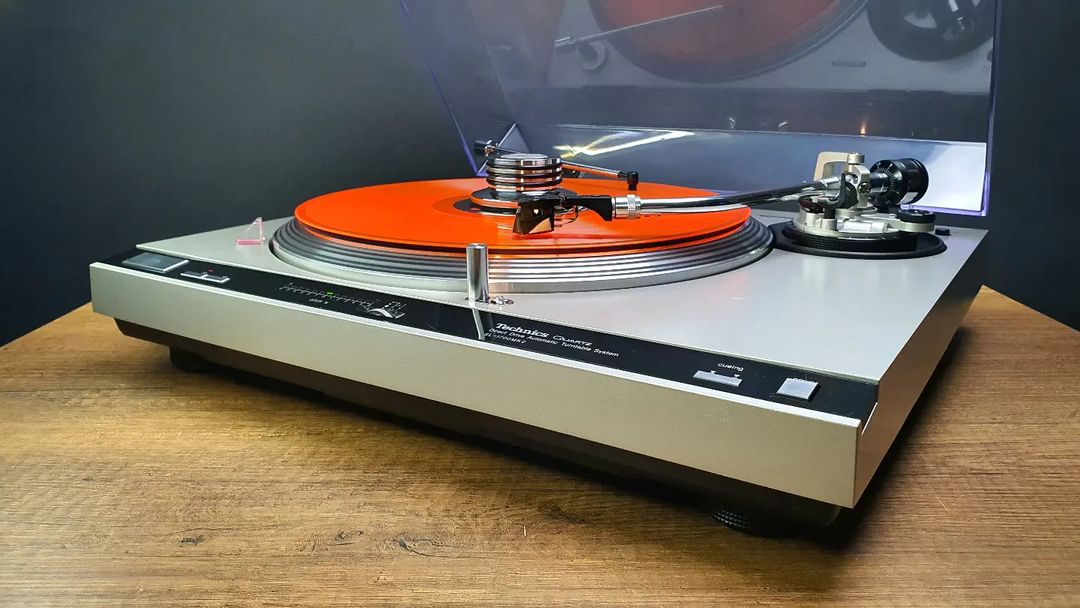
Yeah, I've owned one…several, actually…over the years. They seem to come and go from my life and I never really understand why. They're good, solid tables—they contain the same components as the venerable 1200Mk2 series—and Technics finally addressed the arm cueing issues of the previous Mk2 automatic and semi-automatics with this design.
…and early 00's, Sony had their Discman shit down to an art. It's really too bad the whole product line died only a couple years later with the advent of the iPod because it really is amazing technology.

Yeah, the Discman cases went all plastic, but everything was now consolidated onto a single circuit board, a definite improvement in terms of serviceability. Remove four screws from the bottom and the top/tray pops right off…unlike my beloved D-10 which has two double-sided circuit boards linked by a ribbon cable, multiple wire connects, and is much more complicated:
Or this, my original D-7 from 1986 with a belt-drive spindle motor. And look at that laser transport!
Still a feat of miniaturization and engineering considering that full-size CD decks only came on the scene a few years earlier.
Remember…obsessed.
Was it worth it?
The Good
The sound quality of this D-10 is absolutely amazing. I can't get over how much better it sounds over my late 90s D-171 that I pulled out of storage a few weeks ago. While I can't do any direct A-B comparisons, just transferring a CD from the D-10 to the D-171 sounds as if I've stuffed cotton in my ears. I hooked the D-10 into my main stereo system last night via the line out jack on the back of the unit, and while it didn't sound as good as my modern Yamaha deck, it was certainly nothing to sneeze at.
The build quality is top-notch. As I wrote before, it sports a solid metal case throughout—which was the norm from Sony in 1987. I consider the visual design of the player itself to be one of the company's best, rivaled only by the previous D-7.
(As an aside, I owned a D-7 prior to getting the D-10 in 1987. It too was a fine player, and in fact I'm not sure why I ended up ditching it and getting the D-10, other than the allure of "new, thinner, lighter, shinier" thing. As I wrote previously one or the other of the units—perhaps both, it's been over 35 years now and my memory fails me in these details—had a notoriously wonky headphone jack that required multiple re-soldering jobs on my part to keep it working. That might've been the reason I replaced it with the D-10 if indeed the D-7 was the headphone jack culprit and not the D-10.)
The Bad
Cosmetically the player has its fair share of scuffs and scratches. Not unexpected considering it's age—and I doubt that if I somehow kept my original unit after all these years it would look any better. The scuffs and scratches tend to leap out in photos, but in real life you can't even see them unless you specifically go looking.
When the laser is slewing back and forth while manually selecting tracks (or when the disc ends and it returns to its resting position) it's loud. I don't remember if my original unit was this loud, but I suspect it was. My D-171 is nearly as noisy when performing the same tasks, so I don't think it's a matter of lubrication or anything, as I know this machine was lubed as part of it's refurb. I suspect it's because we've grown so inured to silent devices that provide instant access to our music over the last couple decades we've forgotten how things used to be—and which we were completely fine with at the time.
I've noticed the unit does struggle with certain disks, specifically the "Premium Series" remastered disco albums that I've featured in previous posts. They play, but a lot of audible distortion shows up almost immediately. The discs I have trouble with—as much as I love them—are of…questionable…pedigree, so that may explain a lot of it. With discs from reputable mainstream and indie labels, I haven't had the issue. (They occasionally skip a bit on my D-171, but they play flawlessly on my Yamaha deck.)
The Ugly
As I wrote before, there is absolutely no skip-protection on the D-10.
When this unit came out, The feature hadn't been invented yet (or the cost of implementing it was prohibitive) and it seems all you have to do is sneeze in its general direction and it will jitter and skip. I don't remember my original one being so sensitive but if it was, I wonder how I actually lugged it around San Francisco in my backpack while listening on my daily commute, unless—like the slewing noise—this was just something that was an accepted part of the new technology. But like I said, since it's going to live on my desk and not get used while moving around, this is a moot point…as long as I don't inadvertently bump it! (To its credit, it does recover almost instantly.)
Conclusion
Was it worth it? All things considered, I'm honestly torn between "meh" and "fuck yes!" The one thing that is certain is that I plan on enjoying the hell out of it for years to come, if just for the sound quality alone. I even checked with the guy I bought it from (whose advocation actually seems to be repairing these vintage Discmans) to ask if I can send it back to him for any future repairs, and he said yes. All I have to do is cover the shipping. And he's even someone who enjoys talking shop…

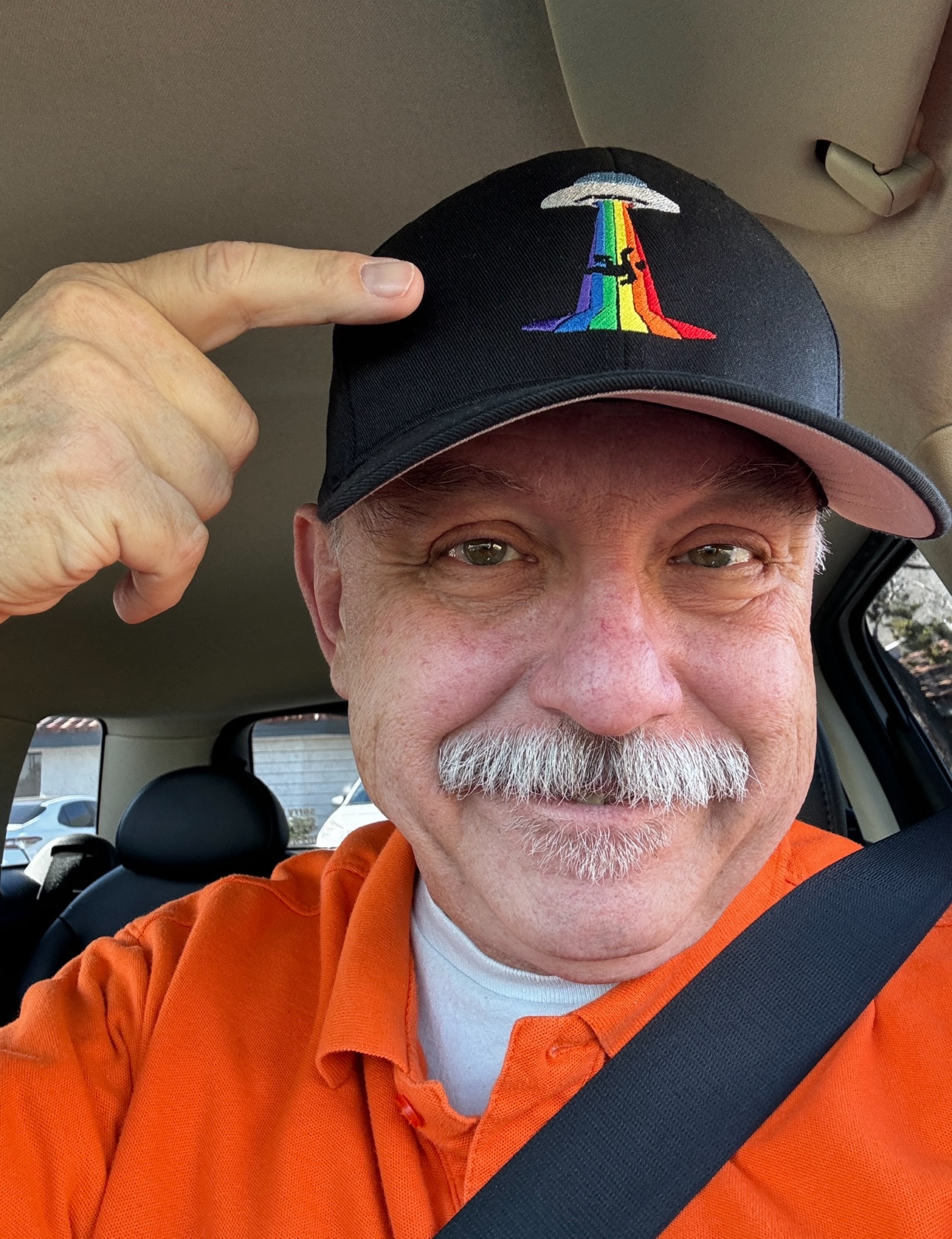

Nostalgia is a part of getting old, right?
The Sony D-10 was the first second portable CD player I owned. (The first was a D-7, and let me tell you that digging up that model number numerous trips to the dusty memory banks in my head, not to mention copious Google searches until I stumbled upon it.) Bought new in 1986 from Jerry's Audio (now a mere shell of it's former self) in Tucson, it went everywhere with me even though this was several years before anti-skip technology and it did tend to lose its mind when jostled too hard. Even without that tech, it still worked surprisingly well when casually walking, but anything more strenuous would send it into a tailspin. This basically relegated it to desk use at work while I was busy creating architectural drawings.
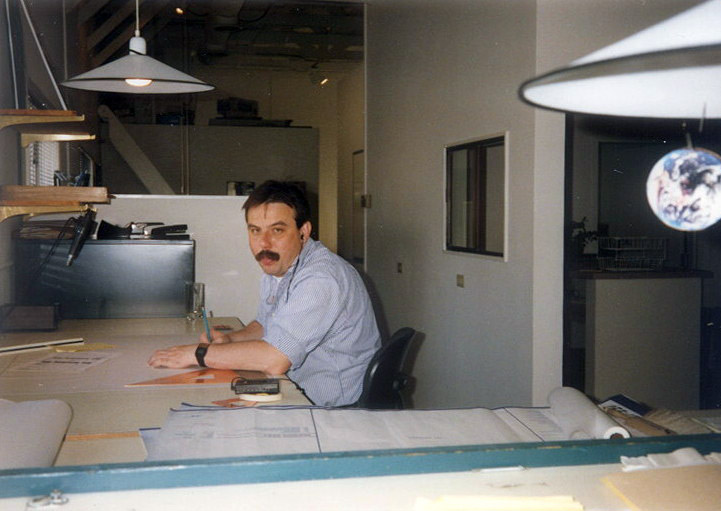
And it wasn't cheap—somewhere north of $300 ($850 in 2024 dollars) as I remember. But damn, it was awesome—and in my mind totally worth it.CDs were still relatively new and just beginning to catch on so was the tech. The unit itself was also heavy; no cheap molded plastic case here; solid metal all the way. It came with a custom rechargeable battery the size of a standard CD case that clipped on the bottom of the device and made connection via spring-loaded gold contacts. Chef's kiss.
As the years progressed, the only thing that proved problematic was the headphone jack. (Kind of an important part, when you think about it, and in all honesty I may be confusing this with the D-7.) The only thing that kept it in place was the jack's soldered electrical connection to the circuit board and with the constant jiggling of the headphones through ordinary use, they'd often crack from the strain and come loose. I don't remember how many times I removed the bottom cover to resolder those joints during ownership. I even shelled out the bucks for the optional remote control and pop-in infrared receiver since I did have it connected to my main stereo more often than not.
I don't remember the circumstances under which I finally let it go, but whenever I see one on eBay these days it brings a tear to my eye and I toy with the idea of replacing it, even with it's known limitations. Unfortunately, fully four fifths of the units up for sale at any given time are marked as "not working/parts only" and those that are working—or god forbid have been properly refurbished—are priced higher than I'm willing to pay for nostalgia's sake. So I admire them from afar and simply enjoy my much more contemporary vintage D-171 that I bought in the late 90s.
The Yamaha amplifier I acquired last year sounds amazing. I fall in love with it all over again every time I power it on and put on some music.
But it has a secret. It's a ticking time bomb. It's not the age; it's generally accepted that Yamaha equipment will outlive all of us if it's properly maintained. The dirty secret is that after being soldered to the main circuit board, several critical components in the power amplifier stage were glued to the board with adhesive that over the years has broken down and become quite corrosive and is known to eat through metal. If left unaddressed this will eventually cause an expensive, catastrophic failure of the unit.
I only learned about this a few months ago, and sadly, the A700 I bought last year is showing this same dreaded corrosion.
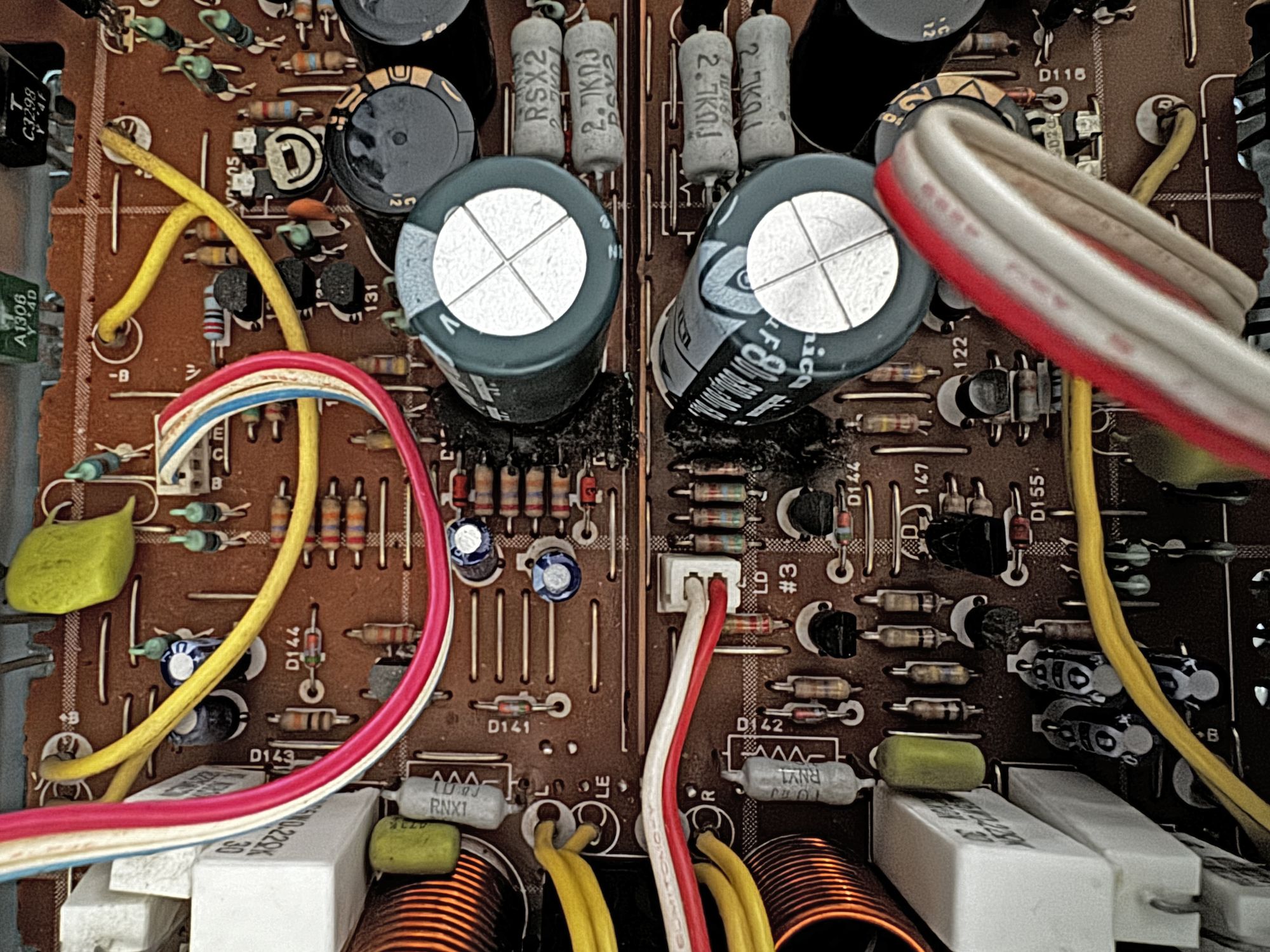
That black goo at the base of those two big capacitors is the corrosive glue. As you can see it's already eaten away at several of the resistors immediately below. And who knows what it's done to the underside of those caps? Might explain why the left channel was occasionally dropping out. The joys of owning vintage HiFi gear, right?
When I first noticed this, I contacted my repair guy up north as well as the local tech I took my Kenwood to last summer, and they both quoted an estimate "in the neighborhood" of $200-300 to clear away the glue, replace all the affected components, and do the general maintenance this unit undoubtedly requires after being in service for the last 40 years.
Shortly after getting this news (and at least in the case of my guy up north, facing the possibility of being without the amp for the better part of a year), I was perusing eBay and ran across an auction for an identical unit that already had this servicing done.

Since I'm on a self-imposed budget I did not immediately smash the "Buy It Now" button. Amazing self-restrait, huh?
Actually, the seller was asking more than I was willing to pay, but I still filed the posting away on my watchlist. Just in case things changed.
About a month ago I got an in-app email from the seller offering a significant discount, bringing the price down into the $200-300 range I'd been quoted for the repair of my unit.
Damn.
But hey, Mercury was retrograde and already chewing me up into a million pieces, and I didn't want to tempt the astrological gods, so once again I fought the urge to hit that button.
Over the past few days, the left channel on the amp has been dropping out with increasing regularity, requiring a bit of volume-knob jiggling to bring it back to life.
Tick tock. Tick Tock. Tick tock.
By now I figured the seller had either sold the unit or removed it from the site, but I went to my watchlist today and amazingly it was still available. Mercury's finally out of retrograde, timing blessed me with an "extra" paycheck this month, so fuck the budget. It's gonna cost the same whether I buy an already-repaired unit or send mine out to get fixed. And I can justify the expense by telling myself I can sell my original unit and probably recoup most of the money spent on the new one.
Happy Early Birthday to Me! I did say it was a sickness…
Cosmetically, it's not quite as nice as my existing unit, but those parts can easily be swapped. The important thing—the guts—are what's important.
What's sad is that this repair isn't that difficult; if I had a modicum of electronics knowledge and didn't have the soldering skills of a six-year-old, it would be something I could easily do myself. But I know that as it stands right now I'd end up making a bigger mess of things than what exists now, so…nope. Leave it to the experts who know what the fuck they're doing.
Where's my pocket protector?!
So as I mentioned in passing a month ago (has it only been a month?) I got this blinkie-light thingie (a power/line level LED meter) for my stereo. For some reason this particular unit is rarer than proverbial hens' teeth (could be the age, or the limited production run, or both), so when it showed up on eBay I immediately snagged it.
I bought one new back in 1979 (minus the oak end panels) when it first came out, but after a decade or so of use I grew weary of it, and somehow it ended up in the trunk (or boot for those in the UK) of my then-boyfriend's car, thinking it would get dropped off at Goodwill at some point. Unfortunately, this was while I was living in SF and because parking on the street is the norm, when the inevitable car break-in happened, it was gone, along with whatever else happened to have been in there.
Anyway, after all these years I thought I knew everything it was capable of doing. What I didn't know—and just discovered today—was that it also had a peak-hold function that displays the highest signal level attained for a small period of time. I knew the silver button on the left side of the unit switched between line-level and RMS (power) display, but I started wondering why in addition to a switch it was also a potentiometer. So I turned it, and all of a sudden the peak levels were holding (the single LEDs that are separate from the main readout in the photo above), similar to how the meters work in my Technics amp. How long they remain on is dependent on how far you turn the knob. Who knew? There is no mention of this whatsoever in the admittedly-sparse instruction booklet—and frankly I think my original unit simply had a standard pushbutton, so it may explain why I missed this all these years. (This unit may be a later production run than what I had originally.) Sadly it only seems to work on the line-level inputs, not the power level side of things, but it's still pretty damn interesting that it can do this.
I'm such a nerd.
So…I did a thing today. 😁 And yes…when all was said and done, IT LIVES! (Color me surprised!)
When I got this 1200MK2 turntable a couple years ago, it came wired with a European electrical plug with a US adapter tacked on. Being the anal-retentive bitch that I am, that wouldn't do. So I ordered a US cord (basically a meter-long extension cord that I cut the end off of) and replaced it. Sadly, I failed to take into account how much of the cable was actually inside the turntable, and the resulting length of the cord was much less than I would've liked, making it difficult to plug into my power strip.
When I pulled the entertainment center out from the wall a couple weeks ago to do some long-overdue cable maintenance, I decided it was time to do something about it. Despite my soldering skills being that of a six-year-old, I felt it was necessary to dive back into the guts of the machine and make this right.
While perusing YouTube later that day, I happened across a video that showed how replace the power cord with a socketed version and another that showed how to install an adapter that allowed you to use any signal cables instead of the mediocre OEM ones that came with the turntable.
I conferred with my friend John (an expert on Technics turntables), showed him the video, and verified he thought this was something I could do myself. (It wasn't rocket science, but with my soldering skills I was naturally nervous.)
Two weeks and about $85 (not counting shipping) later, I had the parts.
The process was surprisingly simple, even with my abilities. (TBH I've seen a lot of electronics repair videos since I initially swapped the power cord on this table so I now knew what mistakes to avoid.) In total, both swaps took about 45 minutes; a lot of that time being taken up with disassembly and reassembly of the table itself. And dare I say it, the new audio cables (nothing special; the same cables I have connecting everything else in my system) I bought for this project actually do improve the sound. (I never thought I'd find myself saying that cables improve sound, but here we are…)
If you've got a SL-1200/1210 MK2/3/4/5 (basically anything prior to the MK7) and hate the original Technics cables, this is a surprisingly easy and recommended project. You can order yours here.